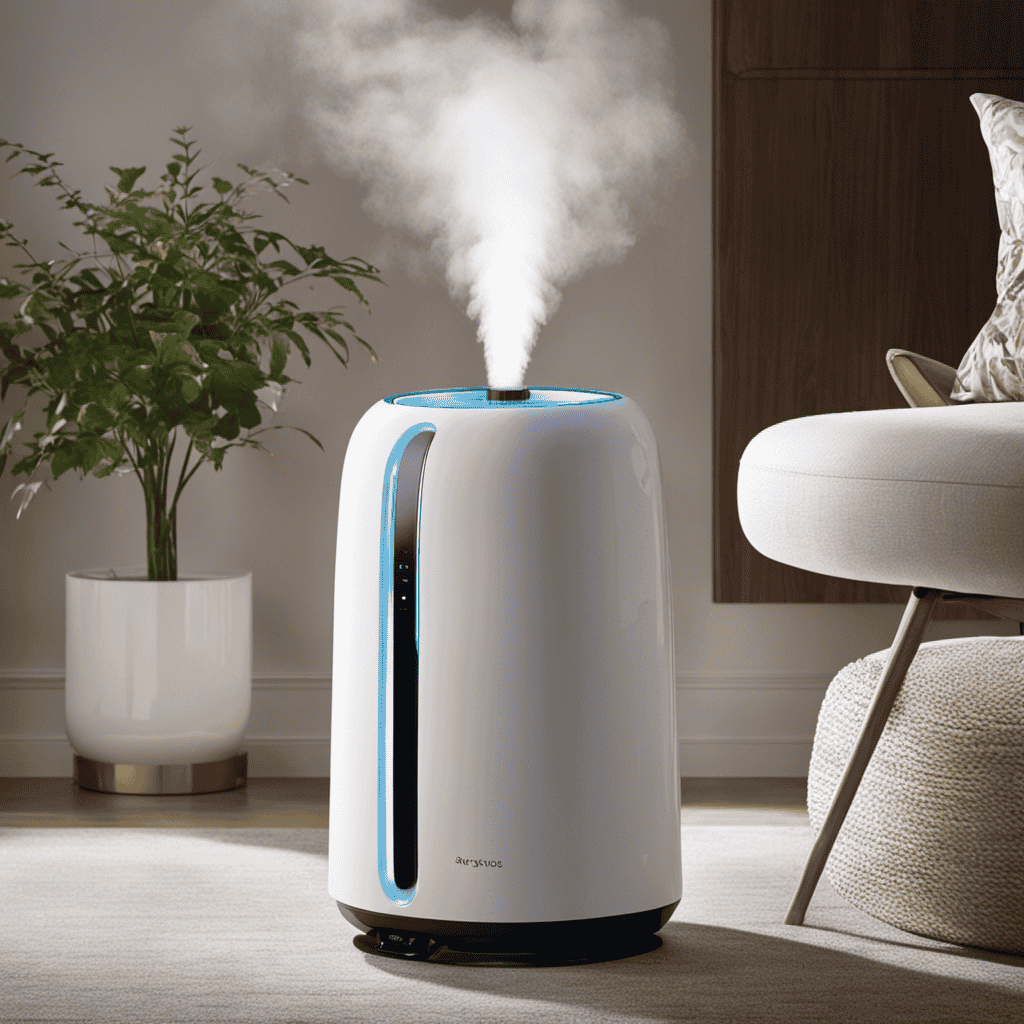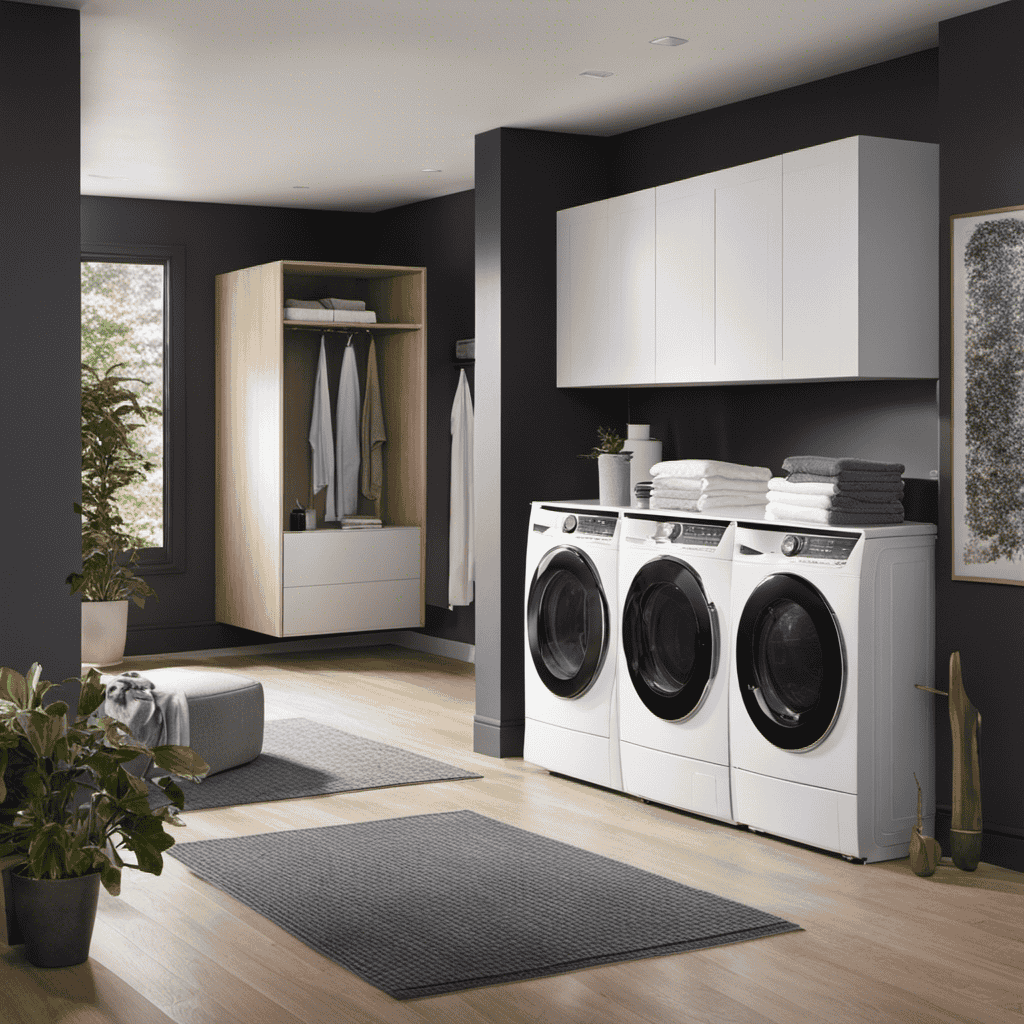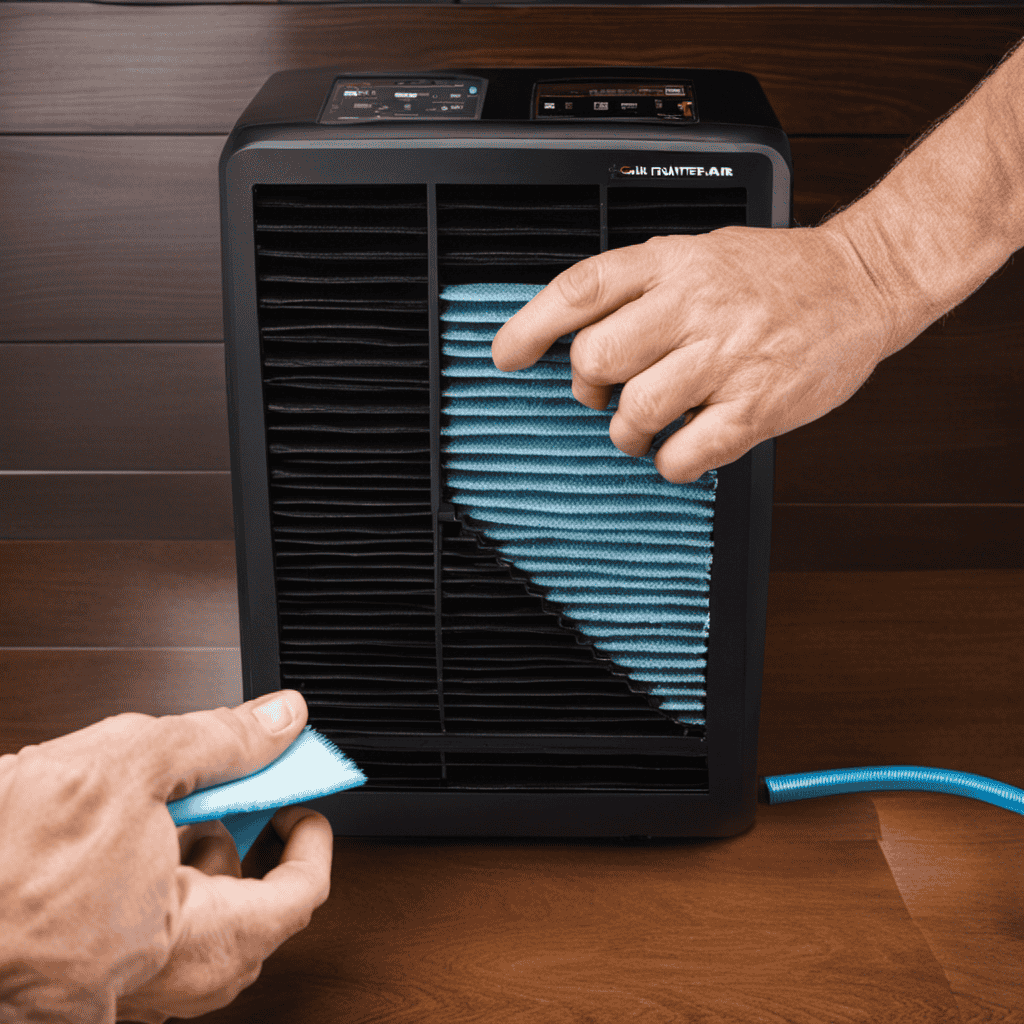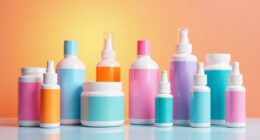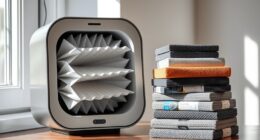I’ve frequently pondered the function of air purifiers. What precisely is their purpose, and how do they operate?
In this article, we will explore the world of air purifiers, from understanding different types of air pollutants to the health benefits they provide.
We’ll dive into the inner workings of air purifiers and discuss important factors to consider when choosing one.
So, if you’re curious about how to improve the quality of the air you breathe, keep reading.
Key Takeaways
- Air purifiers are effective in removing pollutants from the air by filtering out harmful particles like dust, pollen, pet dander, bacteria, and viruses.
- The types of air pollutants that can be removed by air purifiers include particulate matter (PM), volatile organic compounds (VOCs), and gaseous pollutants.
- Using air purifiers can lead to cleaner indoor air, reduce respiratory issues such as asthma and allergies, and improve overall well-being.
- Factors to consider when choosing an air purifier include room size, type of filter, noise levels, maintenance requirements, and brand reputation.
Understanding Air Purifiers
If you’re looking to improve the air quality in your home, an air purifier can be a great solution. Air purifiers offer numerous benefits and are highly effective in removing pollutants from the air.
These devices work by filtering out harmful particles like dust, pollen, pet dander, and even bacteria and viruses. The effectiveness of an air purifier depends on its filtration system, which typically includes HEPA filters or activated carbon filters.
HEPA filters can capture particles as small as 0.3 microns, ensuring that the air you breathe is clean and free from allergens. Activated carbon filters, on the other hand, are excellent at removing odors and chemicals from the air.
With their ability to eliminate pollutants and improve indoor air quality, air purifiers are a worthwhile investment for any home.
Types of Air Pollutants
To understand the importance of using an air purifier, you should be aware of the different types of pollutants that can affect your indoor air quality. Air pollution is a serious issue that can have detrimental effects on our health and well-being. Here are some common air pollutants that an air purifier can help remove:
- Particulate Matter (PM): These are tiny particles suspended in the air, such as dust, pollen, and pet dander.
- Volatile Organic Compounds (VOCs): These are chemicals released from products like paints, cleaning agents, and furniture.
- Gaseous pollutants: These include carbon monoxide, ozone, and nitrogen dioxide, which can come from sources like vehicle exhaust and industrial emissions.
Exposure to these pollutants can lead to various health issues, including respiratory problems, allergies, and even cardiovascular diseases. An air purifier with a high-efficiency particulate air (HEPA) filter can effectively remove these pollutants, improving the air quality in your home and ensuring a healthier living environment.
Health Benefits of Air Purifiers
Air purifiers play a crucial role in improving indoor air quality by removing harmful pollutants, such as dust, pollen, and pet dander. These devices are effective in reducing respiratory issues, such as asthma and allergies, by capturing and trapping these airborne particles.
Multiple studies have shown that using air purifiers can lead to cleaner indoor air, promoting a healthier environment and improving overall well-being.
Cleaner Indoor Air
Improve your indoor air quality by using an air purifier. Indoor pollution can have a significant impact on our health, but with the right air purifier, you can create a cleaner and healthier environment.
Here are three ways an air purifier can improve your indoor air quality:
-
Removes airborne contaminants: An air purifier can capture and eliminate pollutants such as dust, pet dander, pollen, and mold spores, which can trigger allergies and respiratory issues.
-
Reduces odors: Air purifiers equipped with activated carbon filters can effectively remove unpleasant odors from cooking, pets, or smoke, leaving your indoor air smelling fresh.
-
Filters out harmful gases: Some air purifiers are designed to target volatile organic compounds (VOCs) and other harmful gases, helping to improve the overall air quality in your home.
Reduces Respiratory Issues
By using an air purifier, you can significantly reduce respiratory issues caused by indoor pollution.
Indoor air pollution is a major concern as it can lead to various allergies and respiratory problems.
Air purifiers work by removing harmful particles from the air, such as dust, pet dander, pollen, and mold spores, which are common triggers for allergies.
These particles can irritate the respiratory system and cause symptoms like coughing, wheezing, and shortness of breath.
With an air purifier, these particles are trapped and filtered out, resulting in cleaner and healthier air.
This can greatly improve breathing and reduce the risk of respiratory issues.
Removes Harmful Pollutants
Using an air purifier can effectively get rid of harmful pollutants, ensuring a healthier indoor environment.
The air purification process involves several key steps:
-
Filtration: Air purifiers use filters to trap and remove pollutants such as dust, pollen, pet dander, and mold spores from the air.
-
Activated carbon adsorption: Air purifiers equipped with activated carbon filters can effectively remove odors, smoke, and volatile organic compounds (VOCs) from the air.
-
UV-C light sterilization: Some air purifiers utilize UV-C light to kill bacteria, viruses, and other microorganisms that may be present in the air.
By removing pollutants from the air, air purifiers can help reduce the risk of respiratory issues, allergies, and other health problems.
It’s important to choose an air purifier that suits your specific needs and ensure regular maintenance to maximize its effectiveness in creating a cleaner and healthier indoor environment.
How Air Purifiers Work
Air purifiers are essential devices that help improve indoor air quality by removing pollutants and contaminants from the air. Understanding how air purifiers work can give us a better appreciation of their benefits.
The air purification process typically involves multiple stages. These stages include pre-filtration, activated carbon filtration, and high-efficiency particulate air (HEPA) filtration. These stages work together to capture and eliminate various airborne particles and allergens.
Air Purification Process Explained
The purpose of an air purifier is to remove contaminants and improve indoor air quality. Air purifiers achieve this goal through advanced air filtration technology.
Here’s how the air purification process works:
-
Pre-filter: The pre-filter captures larger particles like dust, pet hair, and pollen.
-
Activated carbon filter: This filter uses activated carbon to adsorb odors, gases, and chemicals.
-
HEPA filter: High Efficiency Particulate Air (HEPA) filters are designed to trap microscopic particles, such as allergens, bacteria, and viruses.
By using these filters, air purifiers can effectively remove pollutants from the air, providing clean and fresh indoor air.
The benefits of clean air are numerous. It can enhance respiratory health, reduce allergy symptoms, and improve overall well-being. With the knowledge of how air purifiers work and the benefits they offer, it becomes clear why using purifiers is a wise choice for maintaining a healthy indoor environment.
Benefits of Using Purifiers
Now that we understand how air purifiers work, let’s explore the benefits of using them.
Air purifiers offer several advantages in improving indoor air quality. First and foremost, they help remove airborne particles such as dust, pollen, pet dander, and mold spores, which can trigger allergies and respiratory issues. This is particularly important for individuals with asthma or allergies.
Additionally, air purifiers can help eliminate unpleasant odors caused by cooking, pets, or tobacco smoke. They can also reduce the concentration of volatile organic compounds (VOCs) emitted by household products and chemicals.
Furthermore, air purifiers can help eliminate harmful bacteria and viruses, providing a healthier environment. Studies have shown that using air purifiers can improve sleep quality, enhance concentration, and reduce the risk of respiratory infections.
Overall, the benefits of air purifiers make them a valuable addition to any indoor space.
Factors to Consider When Choosing an Air Purifier
When choosing an air purifier, it’s important to consider factors such as room size and filter type.
The size of the room is crucial because it determines the purifier’s effectiveness in cleaning the air. A purifier that is too small for the room will not be able to effectively remove pollutants, while one that is too large may consume unnecessary energy.
Additionally, the type of filter is vital as it determines the efficiency of the purifier in capturing airborne particles. HEPA filters are considered the gold standard, as they can remove up to 99.97% of particles as small as 0.3 microns.
Other factors to consider include noise levels, maintenance requirements, and the reputation of the brand. Top brands in the market known for their quality and performance include Honeywell, Coway, and Blueair.
Common Features of Air Purifiers
When it comes to choosing an air purifier, two key points to consider are the purification technologies used and the noise level of the device.
Purification technologies are essential in ensuring that the air is effectively cleaned and free from pollutants. It is important to understand the different types of technologies available, such as HEPA filters, activated carbon filters, and UV-C light, to make an informed decision.
Additionally, noise level considerations are crucial, especially if the air purifier will be used in a bedroom or office setting, where a quiet environment is desired for optimal comfort and productivity.
Key Purification Technologies
One of the key purification technologies used in air purifiers is High-Efficiency Particulate Air (HEPA) filters. These filters are designed to remove airborne particles and pollutants, such as dust, pollen, pet dander, and mold spores, from the air. HEPA filters are highly effective in capturing particles as small as 0.3 microns, making them ideal for improving indoor air quality.
HEPA filters use a dense mat of fibers to trap particles. They are capable of removing up to 99.97% of airborne contaminants. HEPA filters are especially beneficial for individuals with allergies or respiratory conditions.
In addition to HEPA filters, air purifiers may also utilize other purification technologies such as activated carbon filters, UV-C light, and ionizers. These technologies work together to provide comprehensive air purification, ensuring that the air you breathe is clean and healthy.
Noise Level Considerations
Noise level is an important factor to consider when choosing an air purifier. A silent operation is crucial for those who want a peaceful and quiet environment. Thankfully, many air purifiers are designed with noise reduction technology to minimize any disruptive sounds. By incorporating features such as soundproof materials, advanced airflow systems, and whisper-quiet fans, these purifiers ensure a tranquil atmosphere while still effectively removing pollutants from the air. To better understand the noise levels of different air purifiers, refer to the table below:
| Air Purifier Model | Noise Level (dB) | Silent Operation |
|---|---|---|
| Model A | 25 dB | Yes |
| Model B | 35 dB | No |
| Model C | 20 dB | Yes |
With this information, you can make an informed decision based on your specific noise preferences and requirements. Now, let’s delve into the next section about air purifiers for allergies.
Air Purifiers for Allergies
If you have allergies, using an air purifier can help reduce the airborne allergens in your home. Air purifiers are especially useful for pet allergies, as they can effectively capture pet dander and allergens associated with pet hair.
When choosing the best air purifier for pet allergies, consider the following:
- HEPA filtration: Look for air purifiers with High-Efficiency Particulate Air (HEPA) filters, as they are designed to capture even the smallest particles, including pet allergens.
- Activated carbon filter: This type of filter helps to remove odors associated with pets, such as urine or pet dander.
- Air changes per hour (ACH): Aim for an air purifier that can provide at least 4 to 6 ACH, as this ensures the air in your home is frequently filtered.
Air Purifiers for Asthma
As someone who suffers from asthma, I understand the importance of finding effective solutions for asthmatic symptoms.
Air purifiers can provide significant relief for individuals with asthma by filtering out common allergens such as dust mites, pollen, and pet dander.
Asthma Relief With Purifiers
Air purifiers can provide asthma relief by removing allergens and irritants from the air. When managing asthma, it is crucial to improve the air quality to minimize triggers and symptoms. Here are three ways air purifiers can help:
-
Filtering out allergens: Air purifiers with HEPA filters can trap tiny particles such as pollen, pet dander, and dust mites, reducing the chances of triggering an asthma attack.
-
Removing harmful gases: Some air purifiers are equipped with activated carbon filters that can effectively remove volatile organic compounds (VOCs) and other harmful gases emitted by household products and pollutants, helping to improve indoor air quality.
-
Reducing airborne irritants: Air purifiers can also capture and eliminate common irritants like tobacco smoke, mold spores, and odors, making the air cleaner and less likely to cause asthma symptoms.
Filtering Allergens for Asthma
To improve your indoor air quality and minimize asthma triggers, you can use an air purifier with a HEPA filter. This type of filter effectively filters out allergens such as pollen, pet dander, and dust mites. Asthma prevention is crucial, and focusing on air quality improvement can significantly reduce the risk of asthma attacks. HEPA filters are designed to capture tiny particles as small as 0.3 microns. This ensures that the air you breathe is clean and free from potential triggers. These filters work by trapping airborne allergens, removing them from the air, and preventing them from circulating in your home. By using an air purifier with a HEPA filter, you can create a healthier environment for asthma sufferers. This can reduce their symptoms and improve their overall quality of life.
Improving Indoor Air Quality
By using an air purifier with a HEPA filter, you can effectively reduce the presence of allergens in your home, improving the indoor air quality. Indoor air pollution is a major concern, as it can lead to various health issues. Here are three benefits of clean air achieved through air purifiers:
-
Elimination of Allergens: Air purifiers with HEPA filters can trap and remove common allergens like dust mites, pollen, and pet dander, providing relief for allergy sufferers.
-
Removal of Harmful Particles: Air purifiers can capture and remove fine particles such as smoke, mold spores, and volatile organic compounds (VOCs), reducing the risk of respiratory problems and other health issues.
-
Odor Reduction: Air purifiers equipped with activated carbon filters can effectively remove unpleasant odors caused by cooking, pets, and chemicals, ensuring a fresh and clean indoor environment.
Air Purifiers for Smoke
Using an air purifier can help reduce the presence of smoke particles in your home. Air purifiers are effective at filtering out smoke particles, which can be particularly beneficial for individuals with allergies or asthma.
These devices work by pulling in air and trapping harmful particles, such as smoke, in a filter. The HEPA (High-Efficiency Particulate Air) filter is commonly recommended for smoke removal, as it can capture particles as small as 0.3 microns. Additionally, activated carbon filters are useful for removing odors associated with smoke.
When choosing an air purifier for smoke, it is important to consider the size of the room and the CADR (Clean Air Delivery Rate) of the device. It is also worth noting that some air purifiers are specifically designed to tackle pet hair and dander, offering additional benefits for pet owners.
Overall, investing in an air purifier can greatly improve indoor air quality and provide relief for those affected by smoke particles and allergens.
Air Purifiers for Pet Dander
When selecting an air purifier for pet dander, it’s important to consider the size of your room and the CADR of the device. Pet dander, which includes pet hair and other allergens, can be a major concern for pet owners with allergies.
To effectively reduce pet allergens in your home, here are a few key factors to consider:
-
HEPA Filtration: Look for an air purifier with a high-efficiency particulate air (HEPA) filter. This type of filter can capture small particles, such as pet dander, and help improve the air quality in your home.
-
Activated Carbon Filter: An activated carbon filter can help eliminate odors associated with pets, such as pet urine or litter box smells.
-
Air Changes per Hour (ACH): Consider the ACH rating of the air purifier, which indicates how many times the device can clean the air in a room within an hour.
By choosing an air purifier that incorporates these features, you can effectively reduce pet allergens and create a healthier environment for both you and your furry friend.
Now, let’s explore air purifiers for dust and pollen.
Air Purifiers for Dust and Pollen
To effectively reduce dust and pollen in your home, it’s important to choose an air purifier with a high-efficiency particulate air (HEPA) filter. These filters are designed to capture particles as small as 0.3 microns, effectively trapping dust, pollen, pet hair, and other allergens. Air purifiers with HEPA filters are especially beneficial for individuals with seasonal allergies, as they can significantly reduce the presence of allergens in the air.
Here is a comparison table of popular air purifiers for pet hair and seasonal allergies:
| Air Purifier Model | HEPA Filter | Coverage Area | Noise Level |
|---|---|---|---|
| Model A | Yes | 500 sq ft | 25 dB |
| Model B | Yes | 800 sq ft | 30 dB |
| Model C | Yes | 1000 sq ft | 35 dB |
Air Purifiers for Mold and Mildew
If you’re dealing with mold and mildew issues in your home, it’s crucial to choose an air purifier that effectively targets and eliminates these contaminants. Mold and mildew can thrive in humid environments, so it’s important to consider air purifiers specifically designed for humidity control. These purifiers typically have features like dehumidifiers or humidistats to regulate the moisture levels in your home.
Additionally, air purifiers that are effective at eliminating bacteria and viruses are also essential. Look for models with HEPA filters, which can capture small particles as small as 0.3 microns, including bacteria and viruses. These filters work by trapping airborne particles and preventing them from recirculating back into the air.
To ensure a healthy and mold-free environment, it’s important to choose an air purifier that addresses both humidity control and the elimination of bacteria and viruses.
Transition: Now that we’ve covered air purifiers for mold and mildew, let’s explore the next section on air purifiers for VOCs and chemicals.
Air Purifiers for VOCs and Chemicals
Consider models with activated carbon filters that effectively trap and neutralize volatile organic compounds (VOCs) and chemicals, providing cleaner and fresher indoor air.
Air purifiers specifically designed for formaldehyde removal are highly effective in improving indoor air quality. Formaldehyde is a common VOC found in many household products, such as furniture, flooring, and cleaning supplies. Exposure to formaldehyde can cause respiratory irritation, headaches, and other health issues. By using air purifiers that target formaldehyde, you can reduce the levels of this harmful chemical in your home, creating a healthier living environment.
These air purifiers work by utilizing activated carbon filters, which have a high affinity for formaldehyde molecules, trapping and removing them from the air. With the use of air purifiers for formaldehyde, you can significantly improve the indoor air quality in your home.
Now, let’s explore air purifiers for odor elimination.
Air Purifiers for Odor Elimination
You’ll be amazed at how well these activated carbon filters eliminate odors in your home. Air purifiers are often used to tackle the problem of unpleasant odors caused by pets or cooking. These powerful devices can efficiently remove the particles responsible for these smells, leaving your home smelling fresh and clean.
Here are three reasons why air purifiers are effective in eliminating odors:
-
Capture and trap pet odors: The activated carbon filters in air purifiers have the ability to adsorb and neutralize pet odors, such as urine or dander, effectively. They work by trapping the odor-causing molecules within the porous structure of the carbon.
-
Neutralize cooking smells: Cooking smells can linger in your home for hours or even days. Air purifiers with activated carbon filters can quickly neutralize these odors by adsorbing the volatile organic compounds (VOCs) released during the cooking process.
-
Improve indoor air quality: By eliminating pet odors and cooking smells, air purifiers help improve the overall indoor air quality in your home. They ensure that you and your family can breathe in clean, odor-free air, promoting a healthier and more comfortable living environment.
Investing in an air purifier specifically designed for odor elimination can make a significant difference in the air quality of your home, providing a fresh and pleasant living space.
Maintaining and Cleaning Your Air Purifier
To keep your air purifier running efficiently, it’s important to regularly clean the filters and replace them when necessary. Proper maintenance ensures that the purifier effectively removes pollutants from the air, providing cleaner and healthier indoor environment. When it comes to cleaning techniques, it’s best to follow the manufacturer’s instructions. Typically, filters can be cleaned by gently vacuuming or rinsing with water. However, some filters may need to be replaced entirely. Regularly inspecting the filter for dirt and debris accumulation is crucial. Here are some maintenance tips to keep in mind:
| Maintenance Tips | Cleaning Techniques |
|---|---|
| Regularly clean or replace filters | Vacuum or rinse with water |
| Check for dirt and debris accumulation | Follow manufacturer’s instructions |
| Keep the air purifier in a clean environment | Replace filters when necessary |
| Use a soft cloth to wipe the exterior of the purifier | Regularly inspect filters for cleanliness |
– What Are the Benefits of Using an Air Purifier?
Using an air purifier offers numerous benefits for improving indoor air quality. The purpose of air purifiers is to eliminate harmful particles such as dust, pollen, and pet dander, which can trigger allergies and respiratory issues. Cleaner air can lead to a healthier home environment and reduce the risk of illness.
Frequently Asked Questions
Can Air Purifiers Remove Viruses and Bacteria From the Air?
Air purifiers can remove viruses and bacteria from the air through their advanced filtration systems. Their effectiveness in eliminating airborne pathogens is due to the technology they use to trap and neutralize these microorganisms.
How Long Does It Take for an Air Purifier to Effectively Clean the Air in a Room?
It takes time for an air purifier to effectively clean the air in a room. Regular maintenance is key to ensure optimal performance. Using an air purifier has numerous benefits, such as reducing allergens and improving indoor air quality.
Are There Any Side Effects or Risks Associated With Using an Air Purifier?
There can be potential side effects and risks when using an air purifier. These include ozone emissions, respiratory irritation, and noise pollution. It is important to research and choose a purifier that meets safety standards.
Can Air Purifiers Help With Reducing Indoor Humidity Levels?
Air purifiers can help reduce indoor humidity levels by filtering out excess moisture from the air. This can be beneficial for people with allergies or asthma, as it helps create a drier and healthier indoor environment.
Are There Any Specific Air Purifier Brands or Models That Are Known to Be More Effective Than Others?
In my opinion, some air purifier brands or models may be more effective than others based on air purifier reviews. It is recommended to research and compare different models to find the best air purifier for your needs.
Conclusion
In conclusion, air purifiers are a must-have for any home or office. They are designed to remove harmful particles from the air, ensuring a clean and healthy environment.
It’s ironic how something as simple as an air purifier can have such a significant impact on our well-being. With their ability to tackle mold, chemicals, and unpleasant odors, these devices are like superheroes in disguise.
So, don’t wait any longer, invest in an air purifier today and breathe in the irony of a cleaner and fresher air.

